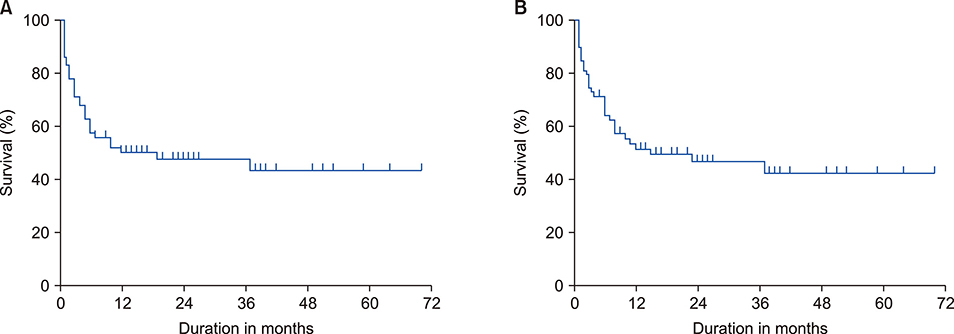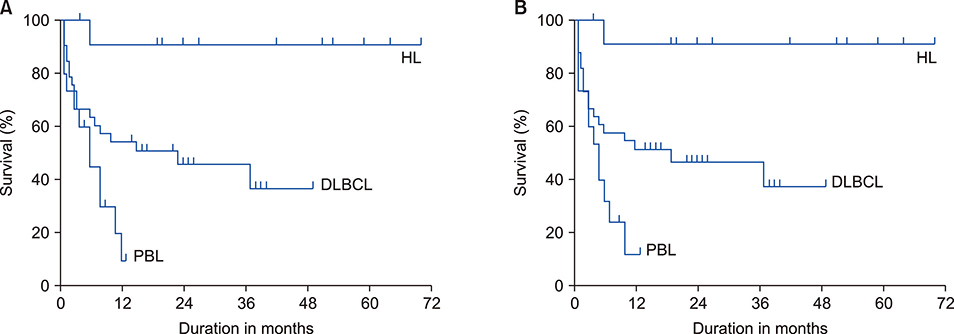Blood Res.
2019 Sep;54(3):181-188. 10.5045/br.2019.54.3.181.
HIV/AIDS-related lymphoma: perspective from a regional cancer center in India
- Affiliations
-
- 1Department of Medical Oncology, Kidwai Cancer Institute, Bengaluru, India. pravin.gmc@gmail.com
- 2Department of Pathology, Kidwai Cancer Institute, Bengaluru, India.
- KMID: 2459383
- DOI: http://doi.org/10.5045/br.2019.54.3.181
Abstract
- BACKGROUND
India has the third largest population of people living with HIV/AIDS (PLHA). Lymphoma is the second most common malignancy among PLHA. However, data are lacking regarding HIV/AIDS-related lymphoma (ARL) in India. This study evaluated the epidemiology and clinical outcomes of ARL from a regional cancer center in India.
METHODS
This retrospective analysis included cases of ARL between March 2011 and September 2017. Data were obtained from patient record files for the assessment of epidemiology and clinical outcomes. Statistical analysis was performed using GraphPad Prism 6. Comparisons of subtype-specific survivals were performed using log-rank tests.
RESULTS
Of 1,226 lymphoma cases, 80 (6.5%) were ARL. Details were available for 70 patients. The median age at diagnosis was 40.5 (9-74) years with a male:female ratio of 2:1. AIDS-defining lymphomas (ADL) constituted 78.6% of cases, while 21.4% had non-AIDS defining lymphoma (NADL). The mean CD4 counts were 193.15±92.85 and 301.93±107.95 cells/µL, respectively (t-test; P=0.0002). Extranodal involvement was present in 55.7%, B symptoms were reported in 60%, and lactate dehydrogenase (LDH) was elevated in 64.3% of patients. The median overall survival times were 6 months for plasmablastic lymphoma (PBL), 23 months for diffuse large B-cell lymphoma (DLBCL), and was not reached for Hodgkin's lymphoma (log-rank test; P=0.0011). Other histological subtype cases were too few to draw meaningful survival outcomes.
CONCLUSION
ARL is a heterogeneous disease. Histologic subtype is a major determinant of the clinical outcome. ADL has significantly lower CD4 counts than those of NADL. There is an urgent and unmet need for uniform management guidelines for improving outcomes in this under-represented patient population.
Keyword
MeSH Terms
Figure
Reference
-
1. UNAIDS. UNAIDS Data 2018. Geneva, Switzerland: UNAIDS;2018. Accessed February 20, 2019. at http://www.unaids.org/sites/default/files/media_asset/unaids-data-2018_en.pdf.2. National AIDS Control Organization. Annual Report 2016–17. New Delhi, India: Government of India;2018. Accessed February 20, 2019. at http://naco.gov.in/sites/default/files/NACO%20ANNUAL%20REPORT%202016-17.pdf.3. Central Drugs Standard Control Organization. National Health Policy. New Delhi, India: Government of India;2017. Accessed February 20, 2019. at https://mohfw.gov.in/sites/default/files/9147562941489753121.pdf.4. Crum-Cianflone N, Hullsiek KH, Marconi V, et al. Trends in the incidence of cancers among HIV-infected persons and the impact of antiretroviral therapy: a 20-year cohort study. AIDS. 2009; 23:41–50.
Article5. Paul TR, Uppin MS, Uppin SG, et al. Spectrum of malignancies in human immunodeficiency virus - positive patients at a Tertiary Care Centre in South India. Indian J Cancer. 2014; 51:459–463.
Article6. Prem S, Narayanan G, Puthuveettil J, Jayasree K, Vijayalakshmi K. Spectrum of HIV/AIDS-associated cancers in South India. J Clin Oncol (ASCO Annual Meeting Abstracts). 2014; 32:Suppl 15. e12534.
Article7. Centers for Disease Control (CDC). A cluster of Kapos's sarcoma and Pneumocystis carinii pneumonia among homosexual male residents of Los Angeles and Orange Counties, California. MMWR Morb Mortal Wkly Rep. 1982; 31:305–307.8. 1993 revised classification system for HIV infection and expanded surveillance case definition for AIDS among adolescents and adults. MMWR Recomm Rep. 1992; 41:1–19.9. Dhir AA, Sawant S, Dikshit RP, et al. Spectrum of HIV/AIDS related cancers in India. Cancer Causes Control. 2008; 19:147–153.
Article10. Haleshappa RA, Koppaka D, Lakshmaiah KC, et al. Patterns of malignancies in patients with HIV-AIDS: a single institution observational study. J Community Support Oncol. 2018; 16:e188–e192.
Article11. Biggar RJ, Chaturvedi AK, Bhatia K, Mbulaiteye SM. Cancer risk in persons with HIV/AIDS in India: a review and future directions for research. Infect Agent Cancer. 2009; 4:4.
Article12. Babu SM, Garg S, Kanakasetty GB, Kuntegowdanahalli LC, Dasappa L, Rao SA. Diffuse large B-cell lymphoma: A retrospective study from a regional care center in South India. Indian J Cancer. 2018; 55:66–69.
Article13. Bower M, Palfreeman A, Alfa-Wali M, et al. British HIV Association guidelines for HIV-associated malignancies 2014. HIV Med. 2014; 15 Suppl 2:1–92.
Article14. Kaplan LD, Abrams DI, Feigal E, et al. AIDS-associated non-Hodgkin's lymphoma in San Francisco. JAMA. 1989; 261:719–724.
Article15. Kaplan LD, Straus DJ, Testa MA, et al. Low-dose compared with standard-dose m-BACOD chemotherapy for non-Hodgkin's lymphoma associated with human immunodeficiency virus infection. National Institute of Allergy and Infectious Diseases AIDS Clinical Trials Group. N Engl J Med. 1997; 336:1641–1648.
Article16. DeMario MD, Liebowitz DN. Lymphomas in the immunocompromised patient. Semin Oncol. 1998; 25:492–502.17. Little RF, Pittaluga S, Grant N, et al. Highly effective treatment of acquired immunodeficiency syndrome-related lymphoma with dose-adjusted EPOCH: impact of antiretroviral therapy suspension and tumor biology. Blood. 2003; 101:4653–4659.
Article18. Sparano JA, Lee S, Chen MG, et al. Phase II trial of infusional cyclophosphamide, doxorubicin, and etoposide in patients with HIV-associated non-Hodgkin's lymphoma: an Eastern Cooperative Oncology Group Trial (E1494). J Clin Oncol. 2004; 22:1491–1500.
Article19. Kaplan LD, Lee JY, Ambinder RF, et al. Rituximab does not improve clinical outcome in a randomized phase 3 trial of CHOP with or without rituximab in patients with HIV-associated non-Hodgkin lymphoma: AIDS-Malignancies Consortium Trial 010. Blood. 2005; 106:1538–1543.
Article20. Barta SK, Xue X, Wang D, et al. Treatment factors affecting outcomes in HIV-associated non-Hodgkin lymphomas: a pooled analysis of 1546 patients. Blood. 2013; 122:3251–3262.
Article21. Mohanti BK, Mukhopadhyay A, Das S, Sharma K, Dash S. Estimating the economic burden of cancer at a tertiary public hospital: a study at the All India Institute of Medical Sciences. New Delhi, India: Indian Statistical Institute, Delhi Centre;2011. Accessed February 20, 2019. at https://www.isid.ac.in/~abhiroop/res_papers/WORKING_PAPERS_files/cancer.pdf.22. Tan B, Ratner L. The use of new antiretroviral therapy in combination with chemotherapy. Curr Opin Oncol. 1997; 9:455–464.
Article23. Torres HA, Mulanovich V. Management of HIV infection in patients with cancer receiving chemotherapy. Clin Infect Dis. 2014; 59:106–114.
Article24. Gopal S, Patel MR, Yanik EL, et al. Temporal trends in presentation and survival for HIV-associated lymphoma in the antiretroviral therapy era. J Natl Cancer Inst. 2013; 105:1221–1229.
Article25. Weiss R, Mitrou P, Arasteh K, et al. Acquired immunodeficiency syndrome-related lymphoma: simultaneous treatment with combined cyclophosphamide, doxorubicin, vincristine, and prednisone chemotherapy and highly active antiretroviral therapy is safe and improves survival-results of the German Multicenter Trial. Cancer. 2006; 106:1560–1568.26. Lim ST, Karim R, Tulpule A, Nathwani BN, Levine AM. Prognostic factors in HIV-related diffuse large-cell lymphoma: before versus after highly active antiretroviral therapy. J Clin Oncol. 2005; 23:8477–8482.
Article27. Thirlwell C, Sarker D, Stebbing J, Bower M. Acquired immunodeficiency syndrome-related lymphoma in the era of highly active antiretroviral therapy. Clin Lymphoma. 2003; 4:86–92.
Article
- Full Text Links
- Actions
-
Cited
- CITED
-
- Close
- Share
- Similar articles
-
- A Case of AIDS Related Non-Hodgkin's Lymphoma
- Malignancies in HIV-infected patients
- Small Bowel Lymphoma Detected by MiroCam(R) Capsule Endoscope in a Patient with Acquired Immune Deficiency Syndrome
- Clinical Guidelines for the Diagnosis and Treatment of HIV/AIDS in HIV-infected Koreans
- Anesthetic Considerations for the HIV-Infected Pregnant Patient




